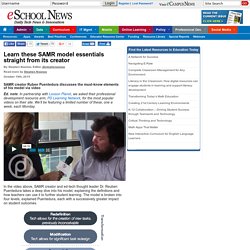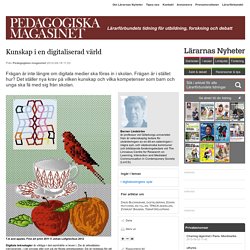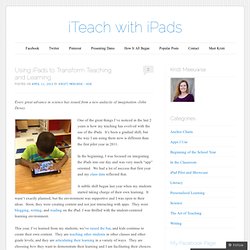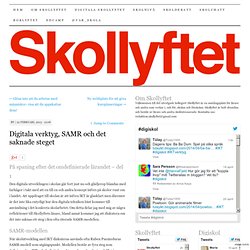

Learn these SAMR model essentials straight from its creator. SAMR creator Ruben Puentedura discusses the must-know elements of his model via video Ed. note: In partnership with Lesson Planet, we asked their professional development resource arm, PD Learning Network, for the most popular videos on their site.

We’ll be featuring a limited number of these, one a week, each Monday. In the video above, SAMR creator and ed-tech thought leader Dr. Reuben Puentedura takes a deep dive into his model, explaining the definitions and how teachers can use it to further student learning. The model is broken into four levels, explained Puentedura, each with a successively greater impact on student outcomes. Substitution. Augmentation. Modification. Redefinition. So, where do you start? As has been pointed out before (see: “The problem with the SAMR model“), redefinition — or even modification — is not always the ultimate goal.
[photo used courtesy of Dr. Kunskap i en digitaliserad värld. T.A and apples.

Fine art print 2011 © Johan Löfgren/bus 2012. TPACK and SAMR Model. GailHolmes-EOL - Classroom Tools. SAMR: The Common truth. Puentedura. Using iPads to Transform Teaching and Learning. Every great advance in science has issued from a new audacity of imagination.

-John Dewey One of the great things I’ve noticed in the last 2 years is how my teaching has evolved with the use of the iPads. It’s been a gradual shift, but the way I am using them now is different than the first pilot year in 2011. In the beginning, I was focused on integrating the iPads into our day and was very much “app” oriented. We had a lot of success that first year and my class data reflected that. A subtle shift began last year when my students started taking charge of their own learning. This year, I’ve learned from my students, we’ve raised the bar, and kids continue to create their own content. Here is an example from Explain Everything. I have no idea what next school year will bring (and goodness knows, I am looking forward to enjoying my summer break!) Wherever you are in your classroom journey, it’s important to reflect on where you are and where you’ve been. Six Minutes with Ruben Puentedura.
Digitala verktyg, SAMR och det saknade steget. På spaning efter det omdefinierade lärandet – del 1 Den digitala utvecklingen i skolan går fort just nu och glädjerop blandas med farhågor i takt med att en till en och andra koncept införs på skolor runt om i landet.

Att uppdraget till skolan är att införa IKT är glasklart men däremot är det inte lika entydigt hur den digitala tekniken bäst kommer till användning i det konkreta skolarbetet. Om detta delar jag med mig av några reflektioner till Skollyftets läsare, bland annat kommer jag att diskutera om det inte saknas ett steg i den ofta citerade SAMR-modellen. Teaching with Technology in the Classroom - Getting Smart by Winifred Kehl - ed tech, education technology, Teaching. Once upon a time, pedagogy and subject matter content were two separate domains.

Teachers were expected to know their subject (reading, math, science, English, etc.) and they were expected to know how to teach a classroom of students. If that strikes you as odd and counterintuitive, you might have a man by the name of Lee Shulman to thank. In the 1980s, Shulman, an educational psychologist, introduced the idea of “pedagogical content knowledge” – knowledge of what methods to use to teach particular subject matter. (For example, check out this study on how to teach physics. ) Shulman argued that treating pedagogy as separate from content knowledge leads to learning environments not ideally suited for the educational task at hand. And this was before the debate over if and how to use technology in the classroom. While pedagogy and content are no long considered mutually exclusive, the question of how to integrate technology into education may not be so nicely settled. SAMRAndTheFlippedClassroom. Tpack.jpg (1635×1650) SAMR - A Model for Instructional Technology Use.
Www.hippasus.com/rrpweblog/archives/2012/01/19/SAMR_GuidingDevelopment.pdf. SAMR Model. 5 Reasons The iPad Will Stay The King of the Classroom. The following piece is by the amazingly talented Adam Webster, Assistant Director of Learning and Teaching at a secondary school in Surrey, England. He writes for both the Edudemic Magazine and his blog ‘ Cageless Thinking ‘ (worth bookmarking).
This article originally appeared on Cageless Thinking and was cross-posted with Adam’s permission. 1. It’s not a laptop The biggest and most oft-heard criticism of the iPad usually revolves around it not behaving like a desktop PC or laptop. The fact that it isn’t a laptop, to me, is its greatest attribute: The SAMR model suggests that there are 4 degrees of sophistication for using technology in education: As you can see from the diagram (created using Paper by Fifty Three) the most sophisticated levels involve ‘Transformation’.
I believe that the iPad makes transformation far more possible, indeed likely, than a laptop. 2. 3. Yes, Apple devices are more expensive than most other devices. TPACK. SAMR.